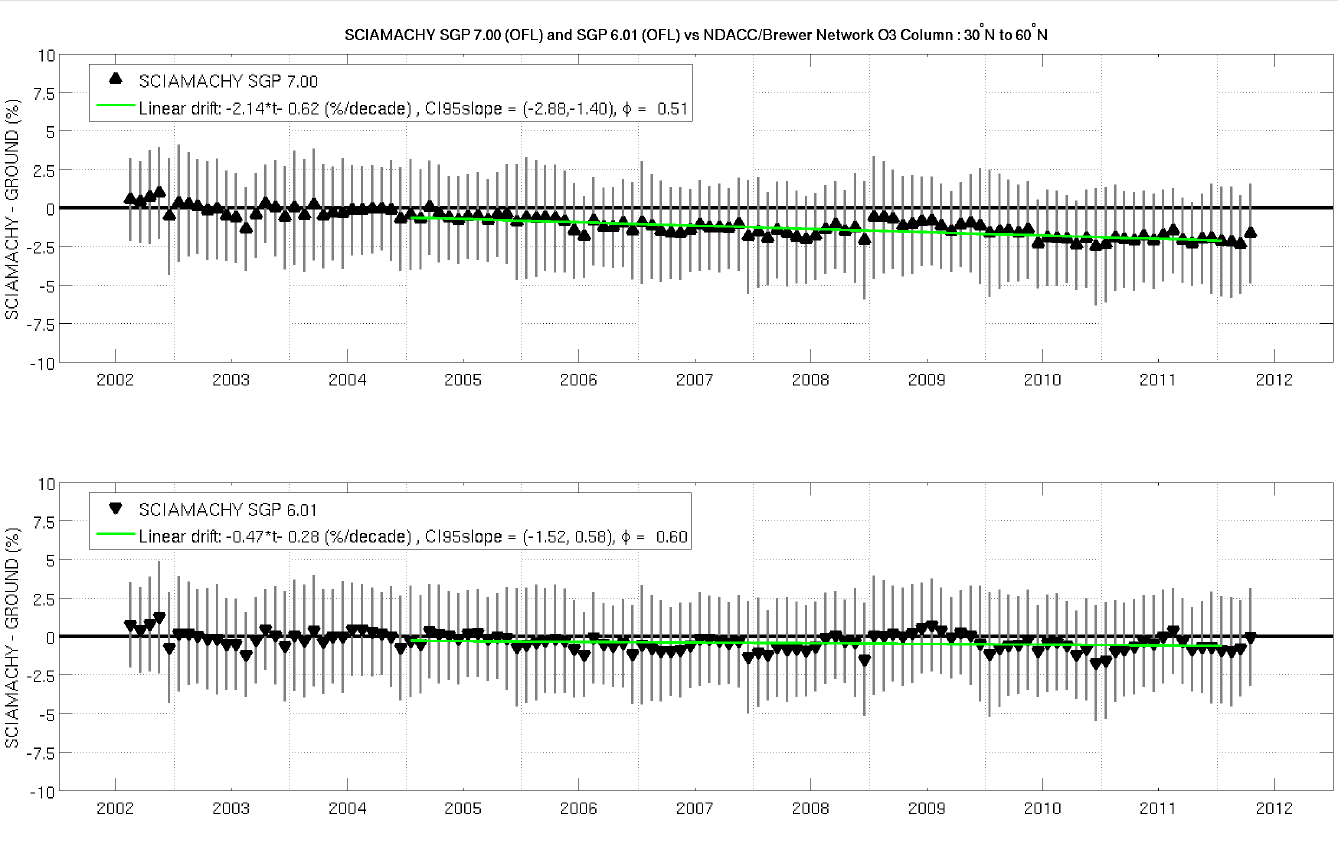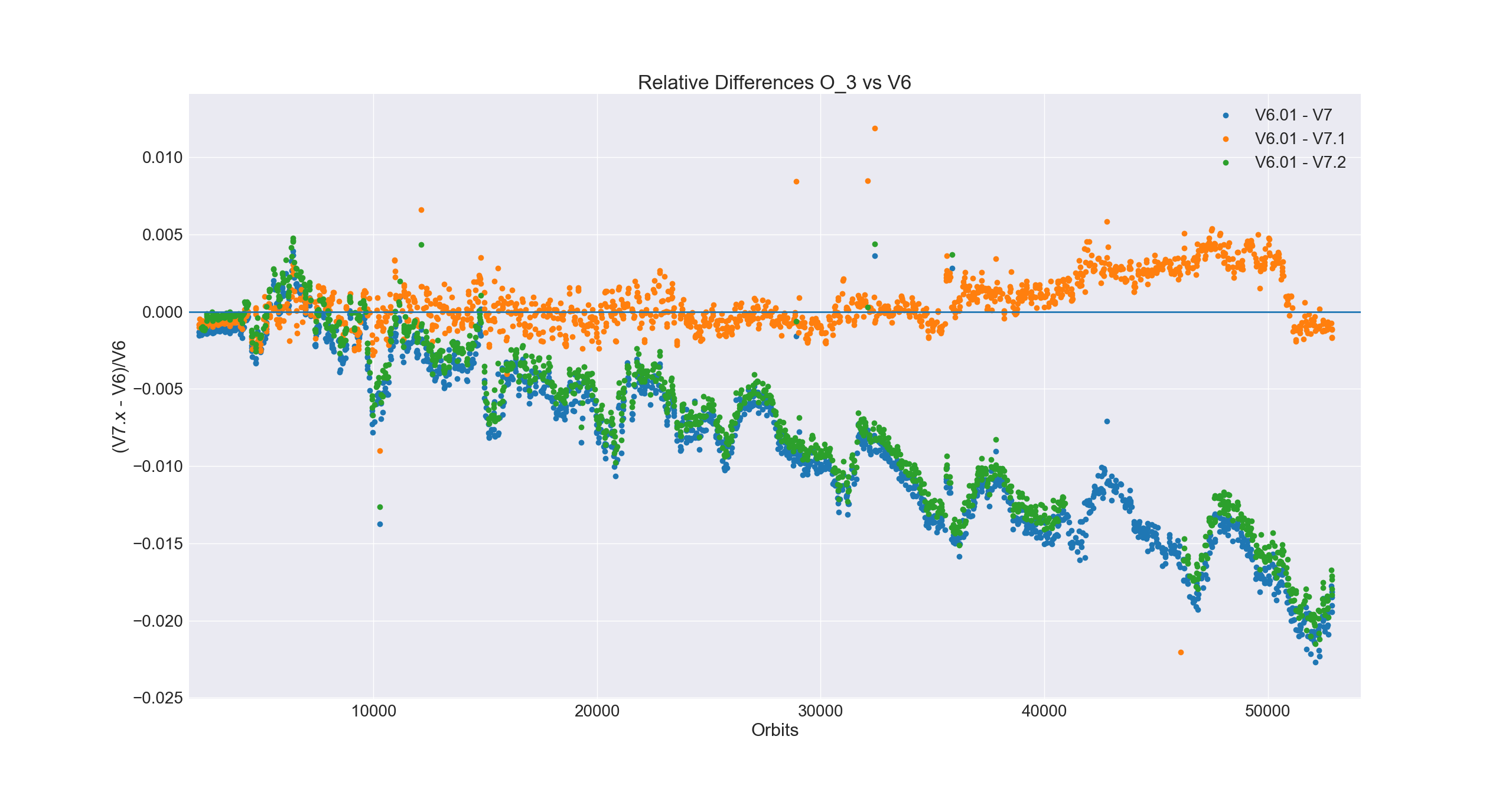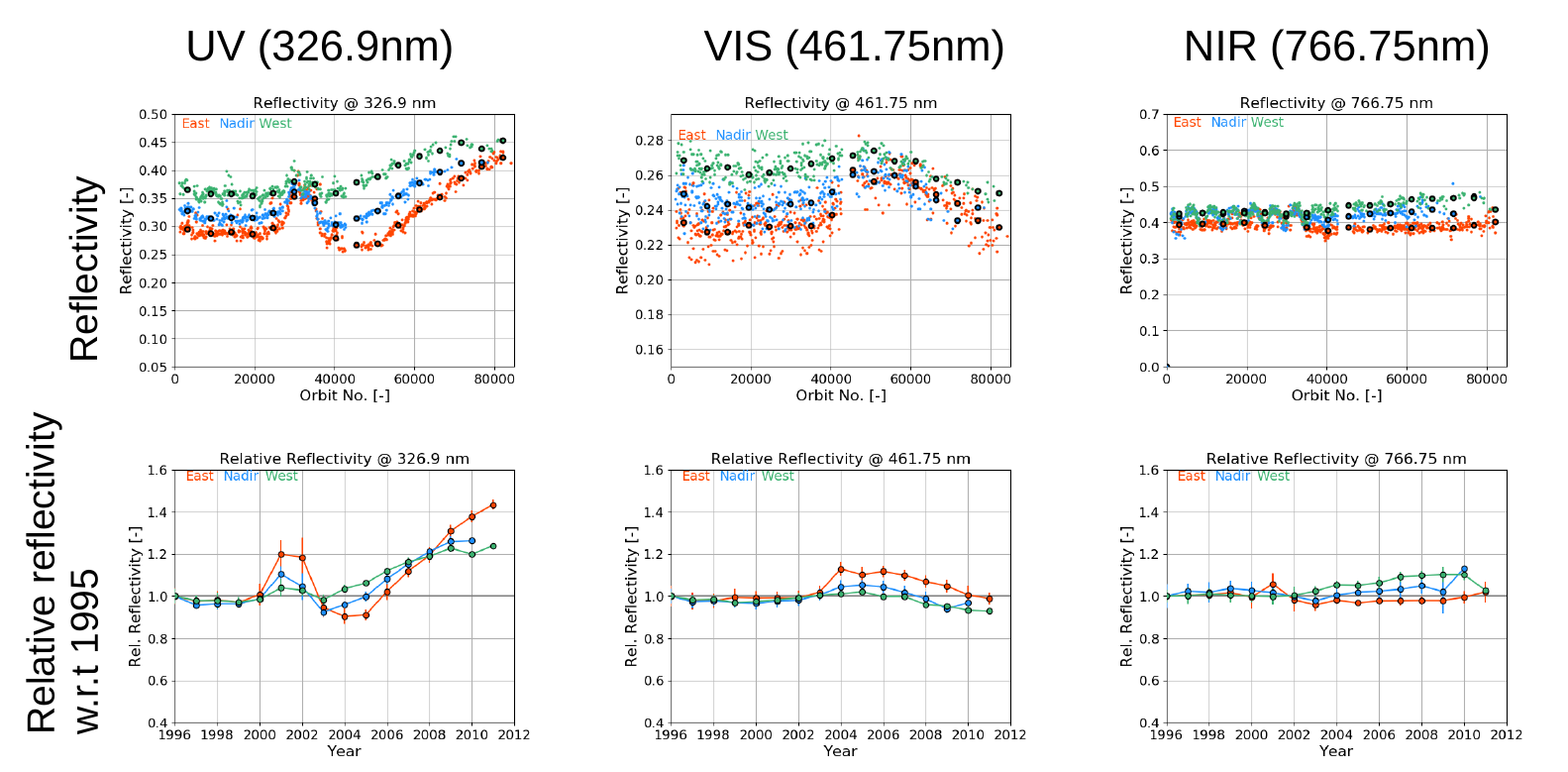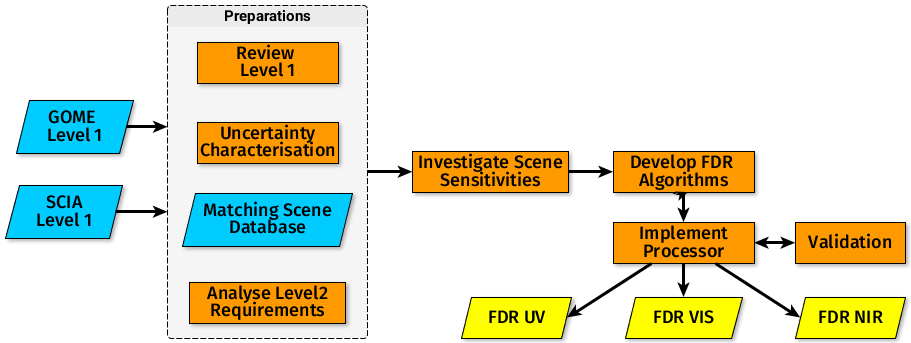The FDR4ATMOS Project
Date
May 4, 2020 10:45 AM
Event
EGU 2020, Online, 4–8 May 2020
Introduction
- The Fundamental Data Record for ATMOSpheric Composition (FDR4ATMOS) project is part of the ESA Long Term Data Preservation (LTDP) programme
- It has two main tasks
- Task A: Correction of SCIAMACHY degradation
- Task B: Creating a cross instrument time series of radiances (Level 1) of GOME-1 and SCIAMACHY
- The project successfully concluded phase 1 with prepatory work
- Phase 2 has just started with an end in October 2022
Goals Task A
Goals Task A
- After the re-processing of SCIAMACHY data with the latest version, O_3 total column data showed a drift
- The previous processor version did not show a drift
- Algorithms for the retrieval were not changed w.r.t. previous processor version
- ⇒ Changes in Level 1 algorithms led to the observed O_3 drift
- The major Level 1 change in the new version was the degradation correction
- Subtle spectral changes mis-interpreted as a O_3 signature could lead to a trend
- In Task A the degradation correction will be updated to correct the drift
Task A: O_3 Validation

Task A: Results
Task A: Quick Look

Task A: Results
- Different solutions were checked
- The best solution leads to an overall degradation correction similar to the previous Level 1 version.
- The solution is empirical, the actual cause of the total ozone trend is not yet clarified.
- The derived total ozone is very similar to Level 2 version 6.01 with deviations below 0.3 % and no trend added.
- Validation using ground based data with an extended data set is under way
Goals Task B
What is a FDR?
FDR
A FDR is a long-term record of selected EO Level 1 parameters, possibly multi-instrument, which provides improvements of performance with respect to the individual mission datasets.
Reminder GOME-1 and SCIAMACHY
Both instruments span 17 years of data. The table shows only the relevant channels for FDR4ATMOS
| GOME | SCIAMACHY | |
|---|---|---|
| Launch | April 21st 1995 | March 1st 2002 |
| End of Mission | July 2nd 2011 | April 8th 2012 |
| Orbit | sun-synchronous, 790 km | sun-synchronous, 799.8km |
| Local Time (DNX) | 10:30 am | 10:00 am ± 5 Min |
| Observation Geometries | Nadir | Nadir, Limb, Occultation |
| Ground Pixel Size | 40 × 320 km^2 | 32 × 233 km^2 to 26 × 30 km^2 |
| Number of channels | 3 | 8 |
| Pixel Per Channel | 1024 | 1024 |
| Total Spectral Range | 237 - 793 nm | 212 - 2386 nm |
| UV Channel Range/Resolution | 311 - 405 nm/0.17 nm | 300 - 412 nm/0.26 nm |
| VIS Channel Range/Resolution | 405 - 611 nm/0.29 nm | 383 - 628 nm/0.44 nm |
| NIR Channel Range/Resolution | 595 - 793 nm/0.33 nm | 595 - 812 nm/0.48 nm |
Goals Task B
- The main objective of the FDR4ATMOS project is to develop a cross-instrument Level 1 product for GOME-1 and SCIAMACHY for the UV, VIS and NIR spectral range
- The focus on the spectral windows used for O3, SO2, NO2 total column retrieval and the determination of cloud properties.
- Contrary to other projects, we do not aim to build harmonised time series based on Level 2 products (geophysical parameters)
- The FDR4ATMOS products will be based on Level 1, i.e. radiances and reflectances.
- The goal of the FDR4ATMOS project is to generate harmonised data sets that allows to use them directly in long-term trend analysis, independently of the instrument.}
Challenges and open points
- GOME-1 and SCIAMACHY do not have exact co-locations (different orbits)
- To avoid a bias due to instrument effects comparison scenes have to cover
- different observation geometries
- different signal intensities
- different signal polarisations
- Spatial resolution of GOME-1 is coarse, but downscaling SCIAMACHY is not useful for Level 2
- Contrary to previous cross-calibrations (e.g. FIDUCEO project) harmonisation has to be done on a highly resolved spectral grid
Challenges and open points - spatial resolution
Coarser GOME resolution consequences
- less cloud free pixels
- hampers detection of sources
- makes ground based validation less representative

Tasks B Breakdown
Preparations and Input
Task Breakdown:
- Preparations:
- Assessment of current Level 1 data
- Establishment of requirements (from Level 2 point of view)
- Updates of degradation corrections (for SCIAMACHY see task A)
- Determination of the error sources and uncertainties
- Input data
- Define matching scene criteria
- Collect matching scenes
- Review on-ground data (for uncertainty analysis)
GOME Degradation
- Reflectivity changes with time, i.e. differential degradation of radiance and irradiance light paths
- Degradation depends on
- Viewing angle (east, nadir, west)
- Spectral region (UV, VIS, NIR)
- More scenes will be investigated, e.g., ocean, ice, deep convective clouds
GOME reflectance at PICS Libya-4 (Sahara desert)

Algorithm Development and Testing
- Algorithm development
- Investigate scene dependencies
- Derive harmonisation model
- Derivation of uncertainties
- Implement processing chain
- Testing
- Test against references (e.g. solar irradiances, CEOS ground scenes)
- Test impact on target Level 2 species
Simplified Flow

Task B Phase 1
Task B Phase 1
In Phase activities
- Summary of calibration chains and first definition of a uncertainty tree
- Assessment of Level 1 data
- Analysis of Level 2 requirements for long term time series
- Establishment of research needs
- Draft of product format
- Draft of validation plan
Summary and Conclusions
- The FDR4ATMOS project aims to
- Deliver high quality SCIAMACHY data by improving the degradation correction
- Deliver FDRs on Level 1 Basis
- In phase 1 the SCIAMACHY degradation correction was updated
- The FDR requirements and research needs were established
- Phase 2 will start in May and aims to
- Generate FDRs of UV, VIS, NIR spectral regions
- Build an operational, quality controlled processing chain
- Deliver FDR products that are in a standard format and easily accessible
- We want to develop methodologies and algorithms for the harmonisation of spectrally resolved data that can also be used for current and future instruments
FDR4ATMOS Team
- DLR-IMF (prime)
- G. Lichtenberg, S. Slijkhuis, M. Hamidouche, M. Coldewey-Egbers, B. Aberle
- IUP Bremen
- S. Noël, K. Bramstedt, T. Hilbig, T. Bösch
- BIRA-IASB
- J.-C. Lambert, J. van Gent, D. Hubert
- NPL UK
- P. Green, S. Hunt
- ESS
- M. Krijger
- ESA
- A. Dehn
- SERCO
- G. Brizzi